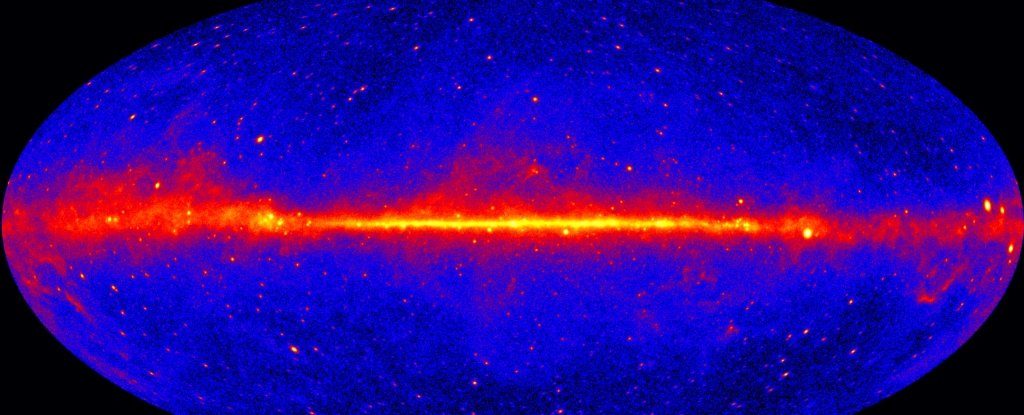
© NASA/DOE/Fermi LAT CollaborationThe Fermi view of the gamma-ray sky.
Astronomers have found that a strange excess of gamma rays coming from the heart of the Milky Way isn't the product of dark matter after all. They argue it's actually coming from a profusion of very old stars that we have yet to identify.
Dark matter can't be detected, and its hypothetical presence can only be inferred by its effect on the space around it. For example, if there's more mass in a region of space than there should be, it's usually attributed to dark matter. That doesn't mean it exists, but it's a useful explanation until a better one comes along.
Something else that has been attributed to dark matter is what astronomers call the gamma-ray excess. It's exactly what it sounds like. Gamma rays are the highest-energy electromagnetic waves in the Universe, produced by the most intense objects - such as pulsars, neutron stars,
colliding neutron stars, black holes, and supernovae.
When NASA's Fermi telescope took a
gamma-ray picture of the Milky Way over
five years, after all known gamma-ray sources were subtracted, we ended up with a gamma-ray glow in the heart of the Milky Way that couldn't be accounted for.
"It is thought that dark matter is composed of Weakly Interacting Massive Particles (WIMPs), which would be expected to gather in the centre of our galaxy,"
said one of the co-authors of the new study, astronomer Roland Crocker from the Australian National University. WIMPs are thought to comprise dark matter.
"The theory is that, very occasionally, these particles crash into each other and radiate light a billion times more energetic than visible light."
In their paper, the researchers from Australia, New Zealand, the US and Germany argue that
the source of the gamma-ray excess is a type of star called a millisecond pulsar.Pulsars are stars at the very end of their life cycle, a type of neutron star or white dwarf. They are so named because they spin very rapidly, emitting beams of radio waves, particles and radiation, such as X-rays and gamma rays. As they spin, these beams flash, very much like an extremely fast cosmic lighthouse."At the distance to the centre of our galaxy, the emission from many thousands of these whirling dense stars could be blending together to imitate the smoothly distributed signal we expect from dark matter,"
Crocker explained.
"Millisecond pulsars close to the Earth are known to be gamma-ray emitters."
The team used hydrodynamical modelling to map the gas associated with diffuse gamma-ray emission, and found that the distribution was non-spherical.
Although the team's paper is based on modelling, not on observation of these pulsars, they argue that statistically, the excess gamma rays are better described by an abundance of stars in the galactic bulge than dark matter.This conclusion also fits because stars in the galactic bulge seem to form an
X-shape, while previous research suggests the dark matter halo is
spherical.
There are other indicators they could be on the right path. Only last month, researchers from the Max Planck Institute for Gravitational Physics detected the
first known millisecond pulsar that does not emit radio waves. It does, however, emit gamma rays - implying the existence of previously unknown gamma-ray pulsars, particularly in the galactic centre.
The team also isn't the first to propose this idea. Last year, researchers from Stanford University proposed that millisecond pulsars may be the source of the gamma-ray excess, partly because the gamma-ray signature, when they examined it, looked different from expected.
"Two recent studies by teams in the US and the Netherlands have shown that the gamma-ray excess at the galactic centre is speckled, not smooth as we would expect for a dark matter signal,"
said Eric Charles of Stanford's Kavli Institute for Particle Astrophysics and Cosmology at the time.
"Those results suggest the speckles may be due to point sources that we can't see as individual sources with the Large Area Telescope because the density of gamma-ray sources is very high and the diffuse glow is brightest at the galactic center."
So the case for pulsars causing the gamma-ray excess is mounting. But not to worry, dark matter fans - the universe is full of unexplained phenomena for which dark matter remains the best explanation. And dark matter hasn't been ruled out for the gamma-ray excess quite yet.
"Ongoing observational and theoretical work is underway to verify or refute the hypothesis that the gamma-ray signal comes from millisecond pulsars,"
Crocker said.
The study has been published in
Nature Astronomy.
Reader Comments